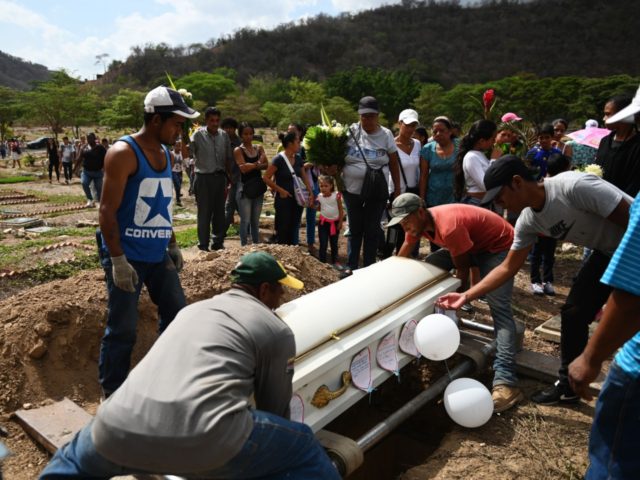The Venezuelan Observatory of Violence (OVV), an NGO that tracks violent crime in the country, found that nearly 1,500 minors were violently killed in 2018, many of them by Nicolás Maduro’s socialist forces, the outlet Runrunes reported on Monday.
Maduro’s Bolivarian National Guard (GNB), the repressive military force most commonly deployed to imprison, attack, and kill political dissidents, has regularly targeted underaged protesters since Maduro replaced late dictator Hugo Chávez in 2013.
The OVV report found that 23,034 Venezuelans died as a result of violence in 2018, among them 1,484 children, according to Runrunes. That means 81.4 out of every 100,000 Venezuelans were killed in violent crime. Most of the minors killed were adolescents and many died while protesting Maduro’s socialist regime.
More than twice as many of those killed in 2018 compared to 2017 died in situations the NGO branded as “resistance to authority,” meaning that Maduro forces did the killing. The total number of minors killed in this fashion was 287, which Runrunes describes as an “exponential” increase in state violence targeting underaged Venezuelans.
That number does not include the deaths of underaged Venezuelans in protests this year, particularly the large wave of counter-Maduro activity following the inauguration of President Juan Guaidó and Guaidó’s call in April for a military uprising. Among the dead this year are Yoifre Hernández Vásquez, 14; Yonder Villasmil, 15; and Yosner Graterol, 16.
Maduro ceased being the legitimate president of Venezuela in January, following the end of his presidential term. Maduro claimed to have won re-election and thus has stayed in the presidential palace, in a May 2018 election that outside observers and local witnesses alike agree was plagued with violent threats to get Venezuelans to vote for Maduro, ballot irregularities, and a ban on non-socialist candidates from running for president. To fill the void left by the end of Maduro’s term, the federal legislature swore Guaidó into power in late January. Most of the free world, and most of the Western Hemisphere, recognize Guaidó as Venezuela’s president.
“How can girls and boys present such an enormous danger to officials armed and equipped with long arms and special protection gear?” Roberto Briceño León, the director of the OVV, said following the publication of the report.
Venezuela banned the private ownership of firearms under Chávez, leaving the civilian, law-abiding population unarmed. Guns are easy to come by in Venezuela, however, for criminals and supporters of the regime. Venezuela’s prisons – the ones that do not house political dissidents – have long been the home of gigantic stockpiles of firearms, some of which found their way on the internet through bragging videos taken by inmates themselves. Maduro has for years armed criminals outside of the prisons in exchange for their loyalty, using socialist gangs known as colectivos to attempt to intimidate and silence dissent. In May, following Guaidó’s failed attempt to gain control of the military, Maduro announced the government would invest in a machine gun manufacturing plan to ensure that his loyalists are armed, despite the ban on gun ownership.
In a separate report detailing criminal violence in the country, the OVV noted that police in Venezuela are very ill equipped to face violent criminals because so many of them have become violent criminals under Maduro’s rule.
“The paradox that the country lives is that the population, under the repressive security system imposed on it, asks the police to apply a firm hand against delinquency,” Briceño noted last week, “but at the same time, they know that this [the police] forms part of that delinquency.”
State violence against minors has become a hallmark of the Maduro regime. Between 2013, the year Maduro took office, and 2014, police homicide of minors went up 55.5 percent. Among those, 90 percent of victims were between the ages of 13 and 17, many killed participating in protests. Among the most notable killings was that of Kluiverth Roa of western Táchira province. Roa, 14, was walking home from school on the afternoon he died when he saw police brutally beating protesters. He did not seek to participate in the protest, his parents later said, but yelled “stop the repression!” at the police. He was shot and killed immediately after.
Nearly 10,000 underaged Venezuelans were the victims of homicide in 2016.
Venezuelans, in general, suffer extreme abuse at the hands of the illegitimate Maduro regime. Provea, another NGO that tracks human rights abuses in the country, revealed in its annual report for 2018 that nearly 1,000 Venezuelans suffered “cruel, inhuman, and degrading” treatment at the hands of their government that year, a 179 percent increase from the year before. Most of these occurred during protests. The GNB often uses tear gas and rubber bullets to weaken the crowd before shooting live fire. In some instances, the soldiers attempt to plow into crowds with armored vehicles, seeking to disperse them. Dissidents have testified to being forced to watch police rape fellow protesters. Those imprisoned say that Venezuelan guards often apply torture to political dissidents, including electrocution, sleep deprivation, and forced to remain in stress positions for hours.

COMMENTS
Please let us know if you're having issues with commenting.